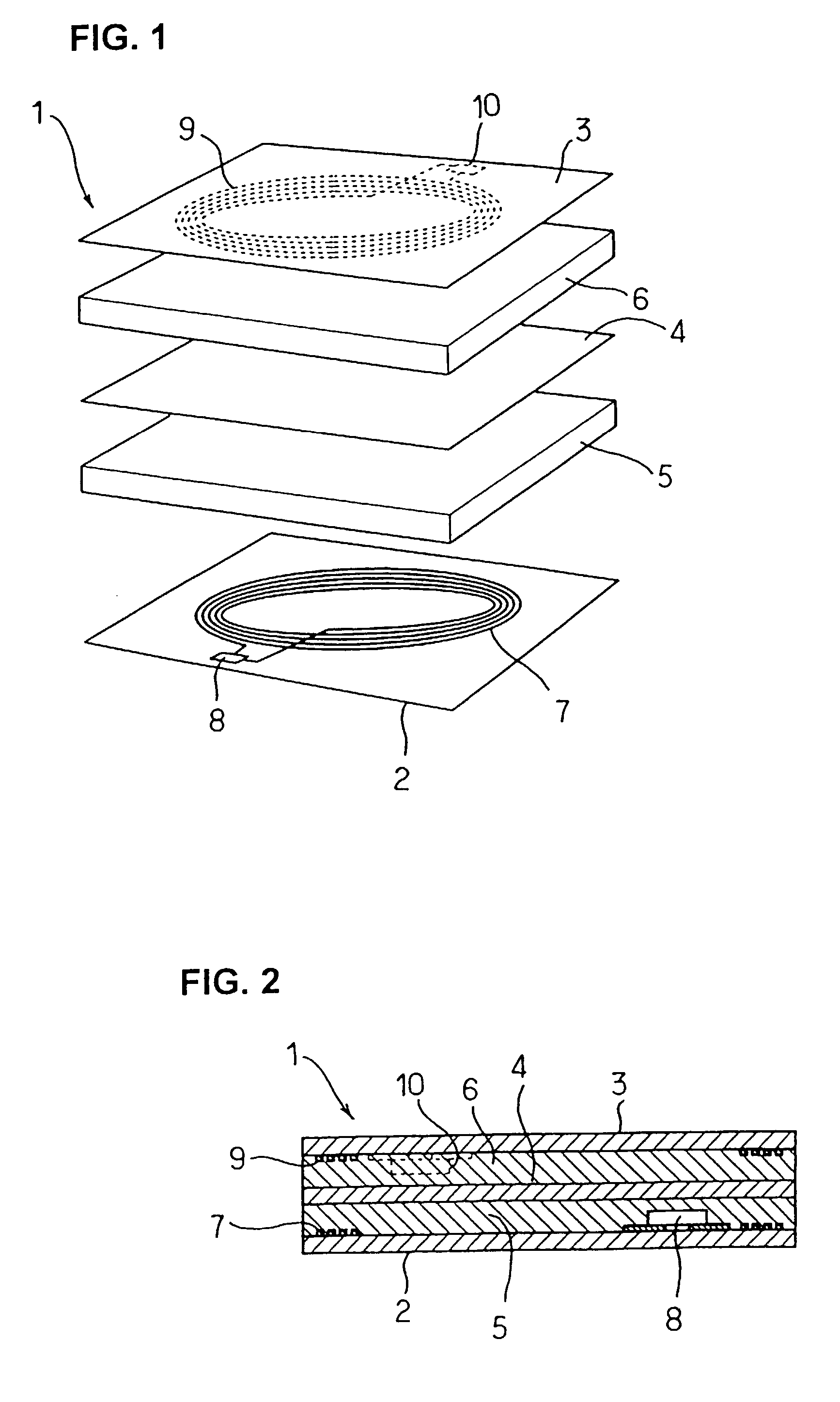Non-contact IC card having enhanced reliability
a non-contact, ic card technology, applied in the direction of instruments, semiconductor/solid-state device details, printing, etc., can solve the problems of excessive failure rate of non-contact ic cards, damage to ic chips, and inoperableness,
- Summary
- Abstract
- Description
- Claims
- Application Information
AI Technical Summary
Problems solved by technology
Method used
Image
Examples
first embodiment
[0023] A first embodiment will be described referring to FIGS. 1 to 3. FIGS. 1 and 2 respectively show an exploded view and a cross-sectional view of this embodiment, which is a non-contact IC card 1. As shown, the non-contact IC card 1 has a sheet 2 constituting a lower-side external cover, a sheet 3 constituting an upper-side external cover, an intermediate sheet 4 disposed between the sheets 2 and 3, an attachment sheet 5 for mutually attaching the sheets 2 and 4, and an attachment sheet 6 for mutually attaching the sheets 3 and 4.
[0024] Each of the sheets 2, 3 and 4 is formed of a film of plastic material which is electrically insulating. The mounting face of sheet 2 (i.e., the upper face as seen in FIGS. 1, 2) has a combination of an antenna coil 7 and an IC chip 8 mounted thereon, with the opposing ends of the antenna coil 7 being connected to the IC chip 8. The antenna coil 7 can for example be formed from a electrically conductive paste, using a screen printing technique, or...
second embodiment
[0047] FIGS. 4A to 4F are diagrams for illustrating a manufacturing process for a second embodiment of a non-contact IC card. Components of this embodiment which are identical to those of the first embodiment are indicated by correspondingly identical reference numerals.
[0048] With the second embodiment both of the combinations of the antenna coil 7, IC chip 8 and the antenna coil 9, IC chip 10, are mounted in common on the same one of the two plastic sheets 2, 3 which constitute the covering of the non-contact IC card. In this case it is assumed that both combinations are mounted on sheet 2.
[0049] The manufacturing process is as follows. Firstly, as shown in FIG. 4A, one of the antenna coils (antenna coil 7) is formed on the upper face of the sheet 2 by a screen printing process using an electrically conductive paste. Next, as shown in FIG. 4B, an electrically insulating layer 11 is formed over the antenna coil 7 on the upper face of the sheet 2, by a printing process using an elec...
third embodiment
[0053] FIG. 5 is a plan view illustrating a third embodiment of a non-contact IC card (as seen with the sheet 3 removed). Components of this embodiment which are identical to those of the second embodiment are indicated by correspondingly identical reference numerals. With this embodiment, as shown in FIG. 5, both the antenna coils 7 and 9 and the IC chips 8, 10 are formed on the same one of the two sheets 2, 3 which form the cover of the card (in this example, on sheet 2). However the antenna coil 9 and IC chip 10 are disposed within the inner periphery of the antenna coil 7, with the IC chip 8 disposed at the outer periphery of the antenna coil 7.
[0054] With the third embodiment, since the configuration of the non-contact IC card is similar to that of the second embodiment, similar advantages are obtained to those described hereinabove for the second embodiment.
PUM
 Login to View More
Login to View More Abstract
Description
Claims
Application Information
 Login to View More
Login to View More - R&D
- Intellectual Property
- Life Sciences
- Materials
- Tech Scout
- Unparalleled Data Quality
- Higher Quality Content
- 60% Fewer Hallucinations
Browse by: Latest US Patents, China's latest patents, Technical Efficacy Thesaurus, Application Domain, Technology Topic, Popular Technical Reports.
© 2025 PatSnap. All rights reserved.Legal|Privacy policy|Modern Slavery Act Transparency Statement|Sitemap|About US| Contact US: help@patsnap.com



